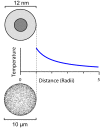Physical limits to magnetogenetics
- PMID: 27529126
- PMCID: PMC5016093
- DOI: 10.7554/eLife.17210
Physical limits to magnetogenetics
Abstract
This is an analysis of how magnetic fields affect biological molecules and cells. It was prompted by a series of prominent reports regarding magnetism in biological systems. The first claims to have identified a protein complex that acts like a compass needle to guide magnetic orientation in animals (Qin et al., 2016). Two other articles report magnetic control of membrane conductance by attaching ferritin to an ion channel protein and then tugging the ferritin or heating it with a magnetic field (Stanley et al., 2015; Wheeler et al., 2016). Here I argue that these claims conflict with basic laws of physics. The discrepancies are large: from 5 to 10 log units. If the reported phenomena do in fact occur, they must have causes entirely different from the ones proposed by the authors. The paramagnetic nature of protein complexes is found to seriously limit their utility for engineering magnetically sensitive cells.
Keywords: biophysics; magnetic control; magnetoreception; neuroscience; none; physical plausibility; structural biology.
Conflict of interest statement
The author declares that no competing interests exist.
Figures


Comment in
-
Problems on the back of an envelope.Elife. 2016 Sep 8;5:e19569. doi: 10.7554/eLife.19569. Elife. 2016. PMID: 27606500 Free PMC article.
References
-
- Chen G. Nonlocal and nonequilibrium heat conduction in the vicinity of nanoparticles. Journal of Heat Transfer. 1996;118:539–545. doi: 10.1115/1.2822665. - DOI
MeSH terms
Substances
LinkOut - more resources
Full Text Sources
Other Literature Sources

